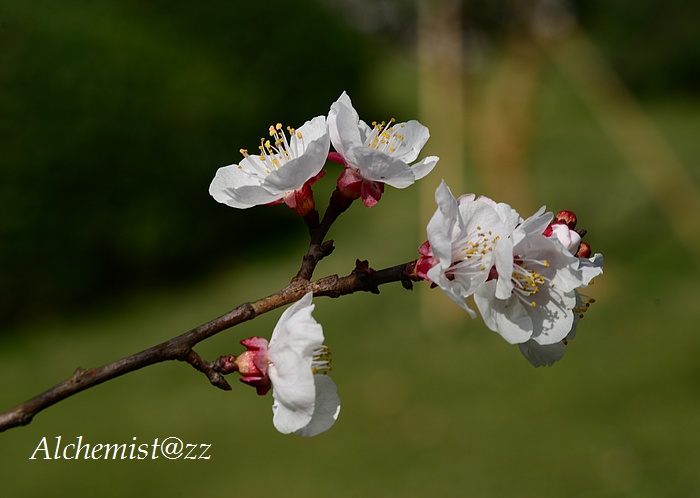杏 Prunus armeniaca
- Scientific Name: Prunus armeniaca L.
- Ref: Sp. Pl. 1:474. 1753
- Synonyms: Amygdalus armeniaca (L.) Dumort.; Armeniaca ansu (Maxim.) Kostina; Armeniaca persicifolia Loisel.; Armeniaca vulgaris Lam.; Armeniaca vulgaris var. ansu (Maxim.) T.T.Yu & L.T.Lu; Prunus ansu (Maxim.) Kom.
- English Common Name: apricot, ansu apricot, Siberian apricot, Tibetan apricot
- Chinese Common Name: 杏 xìng
- Japanese Common Name: アンズ [杏子/杏] anzu, カラモモ [唐桃] karamomo
- Family: Rosaceae
- Genus: Prunus
- Distribution: Sparse forests on mountain slopes, slopes, gullies, also cultivated; 700–3000 m. Gansu, Hebei, Henan, Jiangsu, Liaoning, Nei Mongol, Ningxia, Qinghai, Shaanxi, Shandong, Shanxi, Sichuan, Xinjiang [Japan, Korea; C Asia].
- Photo: 03/15/2014, Hangzhou, Zhejiang
Trees 5–8(–12) m tall, crown spherical, spherical-flattened, or elongated oblong. Bark grayish brown, longitudinally splitting. Older branchlets brownish, glabrous, transversely lenticellate; young branchlets reddish brown, with many pale lenticels. Winter buds purplish red, ovoid, 2–4 mm, glabrous or puberulous at scale margins, apex obtuse. Petiole 2–3.5 cm, glabrous or white pubescent, basally usually with 1–6 nectaries; leaf blade broadly ovate to orbicular-ovate, 5–9 × 4–8 cm, both surfaces glabrous, abaxially pubescent in vein axils, or adaxially white pubescent, base cuneate, broadly cuneate, rounded, or subcordate and with several nectaries, margin crenate, apex acute to shortly acuminate. Flowers solitary or occasionally paired, opening before leaves, 2–4.5 cm in diam. Pedicel 1–3 mm, pubescent. Hypanthium purplish green, shortly cylindrical, 5–7 × 3–4 mm, outside pubescent near base. Sepals purplish green, ovate to ovate-oblong, 3–5 mm, reflexed after anthesis, apex acute to rarely obtuse. Petals white, pink, or tinged with red, orbicular to obovate, 0.8–1.2 cm and ± as broad, margin shortly unguiculate, apex rounded. Stamens 20–100, slightly shorter than petals; filaments white; anthers yellow. Ovary pubescent. Style slightly longer to nearly as long as stamens, basally pubescent. Drupe white, yellow, orange, often tinged red, globose, ovoid, or rarely obovoid, 1.5 to more than 2.5 cm in diam., usually pubescent, glaucous or not; mesocarp succulent, not splitting when ripe; endocarp globose, ovoid, or ellipsoid, compressed laterally, often obtuse at ventral suture and more straight at dorsal suture, with keel-like ribs on ventral side, surface scabrous or smooth, base symmetric or rarely asymmetric, apex obtuse to ± rounded. Seed bitter or sweet. Fl. Mar–Apr, fr. Jun–Jul. (Flora of China)

03/15/2014, Hangzhou, Zhejiang

03/15/2014, Hangzhou, Zhejiang
